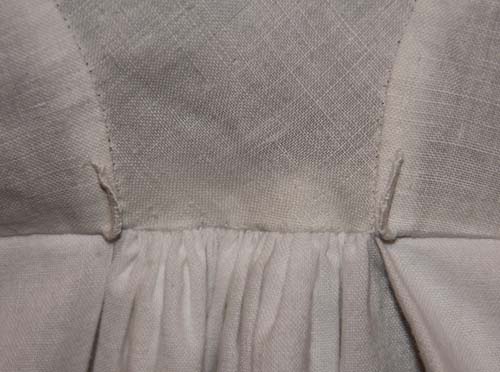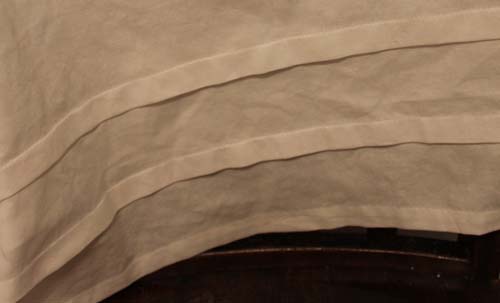Petticoat Acompli
May 21st, 2011
I’m pleased to report that my Empire petticoat is complete! It’s entirely hand-sewn, and despite a skirt that is not quite perfectly balanced, I’m very happy with it!
As revealed in an earlier post, I used a pattern from Janet Arnold’s Patterns of Fashion I: the 1798-1805 morning dress. I simply left off the apron front that would have turned this into a complete dress. The bodice is linen (Arnold’s original had a linen lining to the bodice), but I decided to go with cotton muslin for the skirt — linen would have been far too stiff and heavy.
Here’s the apron part of the skirt — nearly flat at the front, but lightly gathered by the time it reaches the side. It’s set into a very narrow linen waistband that continues to form long ties. The original dress had a front bodice piece attached to this part of the skirt, that buttons on to the rest of the bodice.
The sides and back of the skirt are set into the bodice with a series of pleats at the sides and a small section of gathers at the very back. Also at the back, you’ll see a pair of thread loops that hold the ties from the apron front as they wrap around to tie in front.
I had to resist the urge to over-finish the inside. After running the seams with a modified back-stitch (tiny running stitches with an occasional back-stitch for strength), I trimmed the allowances and overcast them. The neck, arms, and front bodice were simply turned and hemmed.
The skirt is two lengths of 45 inch wide cotton muslin, sewed into a tube at the selvedges (19th-century “sewing” requires no seam allowance when you’re joining selvedges). Since the original pattern called for three breadths of narrower fabric in the skirt, it used the side seams for the apron front opening. My side seams were too far towards the back. Instead, I cut two long slits into the front portion of the skirt and hemmed them with a tiny pleat at the base of the slit. I also hemmed the bottom, and put in two 3/4 inch tucks.
At the top of the skirt, I scooped out an inch from the center front, rising gradually as it came around to the sides. In retrospect, I wish I’d taken more than 1 inch — the bodice rises in the back, pulling the skirt up more than I realized. If I’d followed Arnold’s pattern exactly, this would not have been an issue since the back of her dress has a considerable train that would disguise any shortness.
See how it angles up in the back? You can also see how far back the armscye is set. This is one of the distinguishing markers of an Empire gown, though I rather wonder if mine isn’t a bit extreme.
In the end, I decided not to lace up the front the bodice. In Arnold’s original pattern, she indicates that the bodice lining is simply pinned closed. During the fittings, I was convinced that pins would never hold (the lining provides all the bosom support for this outfit) and that I’d be in constant danger of being stabbed. When I tried it on this morning though, pinned in place, I realized that it really works! So I’m leaving it with pins.
And yes, though cleverly disguised in order to keep this picture viewable, the bodice does not come up high enough to actually cover the bosom. As seen in this picture of the original painting that I’m using for inspiration, the lining is meant to run underneath, supporting, but not concealing.
Now, on to the dress!








It looks lovely! I can’t wait to see what it looks like in person, with the finished dress.